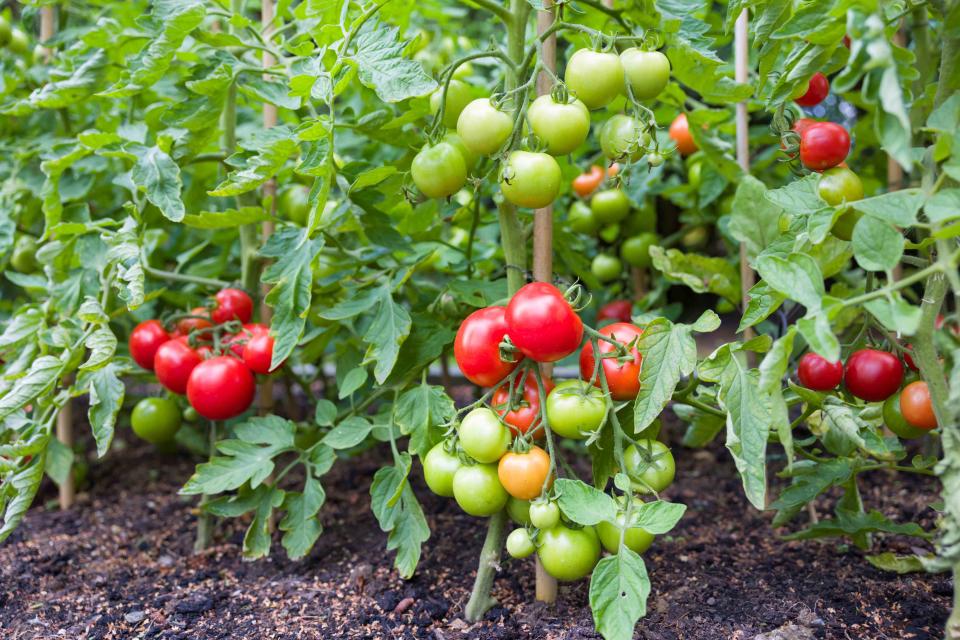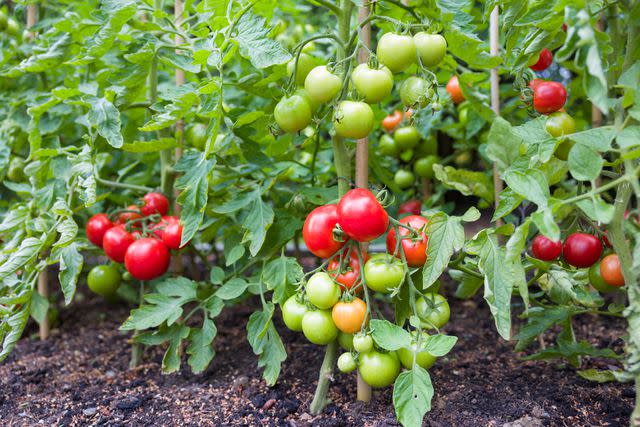9 Must-Know Tips for Creating the Best Soil for Tomatoes
The best soil for tomatoes provides all the nutrients and water your plants need to thrive.

PaulMaguire / Getty Images
The best harvest starts with providing the best soil for tomatoes. Far from glamorous and usually lacking attention, the soil around tomato roots determines the quality and quantity of the harvest. The juiciest, most flavorful, and brilliantly colored tomatoes rise from soil that is rich in organic matter teeming with nutrients that tomato plants need to thrive, along with a host of hardworking soil microbes that contribute to everything from soil drainage to disease resistance. Create the best soil for tomatoes you possibly can with these nine tips.

PaulMaguire / Getty Images
1. Add compost to the soil.
Nutrient-packed compost is the best way to improve any type of garden soil—from heavy clay to fast-draining sand. Compost supplies elements tomato plants need to produce healthy foliage and flavorful fruits. It provides valuable structure to the soil, adding air space and amplifying the soil’s ability to hold moisture. Compost also sustains a multitude of helpful organisms—from beneficial fungi and bacteria to a vibrant earthworm population. In short, compost does more for the flourishing of a tomato plant than any other soil amendment.
Spread a 2-inch-thick layer of compost over the garden in spring before planting. Gently mix it into the top 6 inches of soil. Repeat the process in the fall if the native soil has a high clay content (making it drain slowly) or sand content (causing it to drain quickly). Compost can also be used as mulch around tomato plants during the growing season.
2. Get a soil test.
Get a good read of your local soil with a soil test. Available from state extension services and online commercial soil test labs, a good soil test analyzes the nutrient content of the soil and the soil pH. The test gives a recipe for amending the soil based on the findings. That way you don't have to guess what your soil needs. Instead you'll get specific recommendations for what to add and how much.
3. Rotate planting spots.
Tomato diseases, such as early blight, take up residence in the soil and plague plants year after year. Minimize disease infestations by planting tomatoes in a new location every year on a three-year crop rotation plan. Crop rotation is a great way to keep soil-borne diseases in check.
4. Avoid polluted areas.
Some soil is simply not fit for growing tomatoes. Soil near black walnut trees, for example, isn’t tomato friendly. Black walnut trees exude a chemical called juglone that is toxic to many plants, including tomatoes. Juglone infiltrates the soil beneath the tree canopy and far beyond the drip line. Don’t grow tomatoes near walnut trees; find another location or grow plants in containers.
Urban gardeners need to be vigilant when growing food crops of any sort. Before you plant, research the history of the land where the tomatoes will grow. Avoid areas that might have risks associated with chemical leaching, such as former dry cleaners, gas stations, junkyards, and abandoned manufacturing and industrial sites.
5. Use organic mulch.
Mulching the soil around tomato plants helps keep weeds at bay and conserves soil moisture. When organic mulch, such as compost, shredded bark, or weed-free grass clippings, is used, mulch also improves soil structure. The mulch slowly decomposes and mixes into the top layer of soil, adding nutrients and improving structure.
A 2-inch-thick layer of mulch is an excellent addition to the soil around every tomato plant. Wait to apply mulch until the soil is adequately warm in spring; mulch has an insulating power that is helpful in the heat of summer, but warm soil is necessary to spur growth in spring.
6. Consider raised beds.
Raised beds are a terrific way to mediate troublesome soil for growing tomatoes. If your planting place is plagued by polluted soil, boggy, clay soil, or excessively sandy soil, build a raised bed and fill it with high-quality topsoil. Many easy-to-assemble raised beds are available for purchase.
Related: The 11 Best Raised Garden Beds of 2023
7. Cover crops are a good idea.
Cover crops—also called green manure—planted in early spring or fall improve the garden soil’s structure and fertility. The cover crops for tomatoes are grown until the plants begin to flower, at which time they are cut down and incorporated into the soil. Great cover crops for tomatoes include winter rye, annual ryegrass, and winter wheat.
8. Skip weed-free fertilizer.
When fertilizing tomatoes, read product labels carefully. Fertilizer containing weed-killer is a popular product but is not welcome near tomatoes. The weed-killer portion of the product infiltrates the soil and harms or kills young, tender tomato plants.
9. Don't neglect clean up.
At the end of the growing season, remove any diseased tomato plant parts. Bury or burn the diseased stems and leaves; don't add them to a compost pile. After removing diseased plants, chop the remaining plant parts with a mower set on the highest mowing height and leave the debris in the garden to nourish the soil.
For more Better Homes & Gardens news, make sure to sign up for our newsletter!
Read the original article on Better Homes & Gardens.

